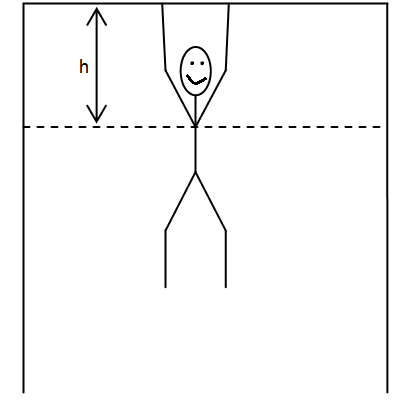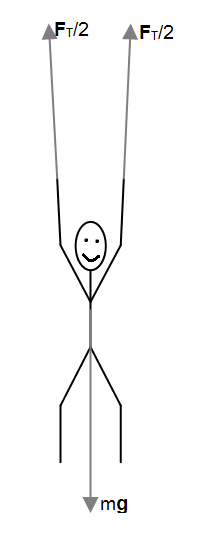Or search by topic
Number and algebra
Geometry and measure
Probability and statistics
Working mathematically
Advanced mathematics
For younger learners
Giant Swing



- Problem
- Getting Started
The average ratio for men $\frac{a}{b} = 0.56$ where $b$ is the height of a man $b = 1.82\mathrm{m}$ and $a$ is the position of mass centre measured from legs. The average length of arms is $32/33\;\mathrm{inches} = 82\mathrm{cm}$ and the average length from the shoulders to the top of the head is $30 \mathrm{cm}$. So, the centre of mass is about $$h = 1.82\mathrm{m} - 0.56\times 1.82\mathrm{m} + 0.82\mathrm{m} - 0.3\mathrm{m} = 1.32\mathrm{m}$$ measured from the wrist.

1) We require that all kinetic energy at the bottom position will be transferred to the potential energy at the top position.
$$\frac{mv^2}{2} = 2mgh$$ where $m$ is the mass of the man, $g = 9.81\mathrm{m/s}^2$ and $v$ is the speed of the centre of mass. Thus, $v = 2\sqrt{gh}$. The angular speed $$\omega = \frac{v}{h} =\frac{2\sqrt{gh}}{h} = 2\sqrt{\frac{g}{h}} = 2\sqrt{\frac{9.81\mathrm{m/s}^2}{1.32\mathrm{m}}} = 5.45 \mathrm{s}^{-1}\;.$$ Notice that the answer is independent of the mass of the man.

2) The force required by the arms can be found if we write the II-Newton's law for the man.
$$ma = F_{T} - mg$$ where $a$ is the centripetal acceleration, $m$ the mass of the man and $F_{T}$ is the tension in the arms. So, $$F_{T} = m(a + g) = m\left(\frac{v^2}{h} + g\right) = m\left(\omega^2h + g\right)\;.$$ Use the expression for $\omega$ from the previous part to get $F_{T} = 5mg$. Suppose that an average man weights $80\mathrm{kg}$. $$F_{T} = 5\times80\mathrm{kg}\times9.81\mathrm{m/s}^2 = 3.9\mathrm{kN}$$ It is a huge force. Notice that this time the answer is independent of the position of the centre of mass.
3) Suppose that the man is spinning with the constant angular speed then $T = 1\mathrm{s}$. Thus, the anglular speed is $\omega =\frac{2\pi}{T} = 2\pi\mathrm{s}^{-1} = 6.28 \mathrm{s}^{-1}$. Similarly as before we write the II-Newton's law at the bottom position to get that the tension in the arms. $$F_{B} = m(\omega^2h + g) = 80\left(4\pi^2\mathrm{s}^{-2}\times1.32\mathrm{m} + 9.81\mathrm{m/s}^2\right) = 4.95\mathrm{kN}$$ or it is about $F_{B} = 6.3mg$.
At the top position $$F_{T} = m(\omega^2h - g) = 80\mathrm{kg}\left(4\pi^2\mathrm{s}^{-2}\times1.32\mathrm{m} - 9.81\mathrm{m/s}^2\right) = 4.3mg = 3.38\mathrm{kN}\;.$$ This time the answer is dependent on both the position centre of mass and the mass of the man.
You may also like
Whirlyball
Whirl a conker around in a horizontal circle on a piece of string. What is the smallest angular speed with which it can whirl?

